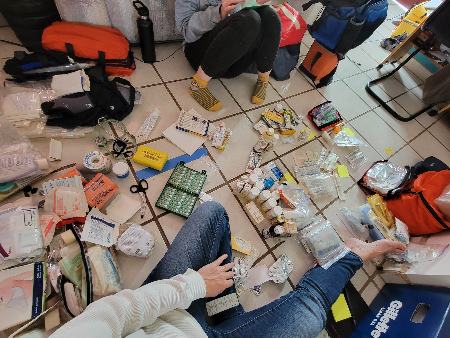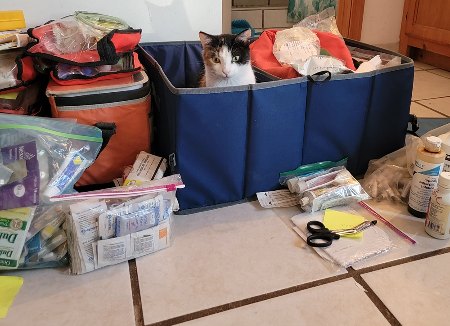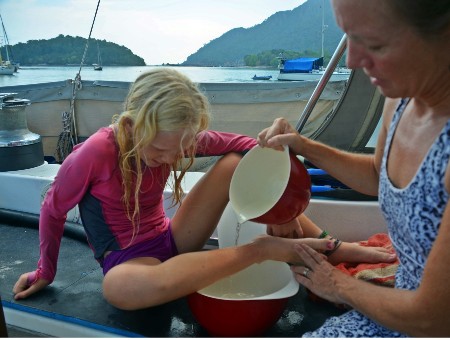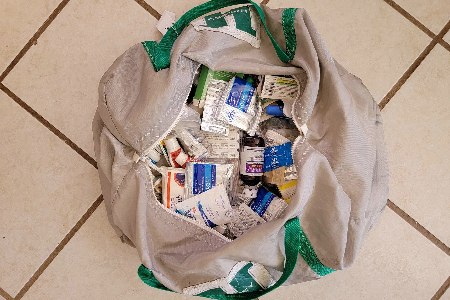INSIGHTS: Medical Kits for Cruising
Before heading off long-distance cruising it’s important to be well prepared for any medical event, including appropriate training for the crew and having a well-stocked medical kit. Behan Gifford of SY Totem gives her thoughts and INSIGHTS into pulling together a usable offshore medical kit for long-term cruising, plus other medical considerations for life on board.
Published 3 years ago
A major part of any cruiser’s medical plan should be training: baseline first aid for all adults on board, but advanced training for at least one and ideally multiple crew. There’s research to understand the risks (and services) for health care along your route. And importantly, a medical kit to stock aboard your boat.
Make your own medical kit
When preparing to set off cruising (we departed from Puget Sound in 2008), Jamie and I decided to put our own kit together instead of buying a prepared one. That required considerable effort on our part, but it was time well spent. We had to determine what should be included; as non-professionals, that’s somewhat outside our comfort zone – but it was valuable information to learn. The training we had (a riff on the Red Cross’ Wilderness First Aid, taught by a physician with cruising ambitions) helped guide the contents, as did our route plan. Each addition to the kit a deliberate choice, but it forced understanding what every item was for, how to use it, and if/when it could expire.


- Refreshing our medical kit.
Pre-packed medical kits
Commercially prepared medical kits designed for offshore use can shortcut the time involved in having a well-stocked kit on board. There are a number available: US-based retailers include OceanMedix, Adventure Medical, and TravelMed and I have listed other worldwide suppliers at the end of this article. Their kits have the advantage of doing much of that thinking for you about contents to include. The best kits are designed for intuitive access to gear based upon the need at hand – be it a burn, a cut, or a sprain.
Make or buy?
If weighing the options on a pre-made vs DIY kit, consider how the commercial version suited it is to your plans. Whether making or buying, it’s important to understand a few details about the contents. While it may seem obvious, you should know what’s inside – not presumed, if ordering from a list to make your own or buying one made for you. Does it meet the needs you anticipate? You should also know how to use the contents. Ask yourself if there are training gaps required for any, and consider closing that gap – or knowing that safe use requires finding the nearest professional, whether that’s another cruiser or at a facility on shore. Finally, consider how well the choices made align with your preferences (e.g., single-use cold packs vs something reusable that works for heat or cold).
Getting prescriptions
Most cruisers don’t need them, or need many. Cruising is overwhelmingly done near-shore or within a day or so of shoreside health care, where it’s better to source antibiotics with professional guidance (to get the right type, with a bonus that they haven’t been cooking in the bilge). But some emergency or rescue medications for pain or anaphylaxis may be minimally necessary, even when near shore. Until you really need them, save the money and the waste.
Some medical kit retailers can sell prescription medication with their kits. Providers I’m aware of include TravelMed, Seaside Marine, MedAire, Ocean Medical International, Duration Health, and OceanMedix.
A travel clinic is another good place to look: you may know what options exist in your hometown. Some national pharmacies have this service, and the International Society of Travel Medicine has a searchable database.


- Banshee the Cat keeps an eye on things.
Resources for putting your own kit together
- Read a book. Dr Michael Beilan’s book, Your Offshore Doctor, includes medical kit contents lists broken out into three levels depending upon whether you will be daysailing, coastal cruising, or offshore/remote. It’s a very sensible approach! The book’s contents help illustrate if/when/how any recommended items are needed and used.
- Talk to your doctor. Ideally a primary care physician is on board with your plans. They know you and your history, can guide recommendations for contents, and hopefully will write any prescriptions you want for it. What better than understanding (and access) to someone who has that context?
- Hire a Pro. When putting our medical kit together anew this year, we consulted with Jeffery Fine at West Street Medical in Annapolis, MD. Jeff is a physician’s assistant with 30 years of emergency medical experience: a wealth of knowledge to review our 14-year-old kit and shape the 2022 version. He worked with us remotely, but if you can schedule time when you pass through Annapolis for the boat show; for in-person visits, Jeff can help with vaccinations updates and prescriptions for your kit.
Don’t forget everyday needs!
It may sound obvious, but make sure that in the rush to be ready for a head gash or limb fracture that you haven’t forgotten about managing basic health needs. You’re more likely to deal with the common cold than a sucking chest wound or limb fracture; be ready for the mundane health events, too.


- Treating a jellyfish sting onboard Totem.
Learning from our first medical kit
After 14 years cruising, we’re cleaning out the medical kit that grew bloated over the years with additions from our purchases as well as the gifted contents of kits from friends retiring from cruising. The good news is that we didn’t touch most of it. There were no dire medical emergencies; when we needed antibiotics (rare!), we always had professional advice and almost always had access to a local pharmacy. Culling the expired and no-longer-sterile contents was somewhat sobering, and felt wasteful – but also a chance to be grateful for what we hadn’t needed.


- It’s a good idea to disposed of expired medicines.
We also know a lot more about what we DO use. While they tended toward the pedestrian supplies, we’re going to be much better prepared for the most common maladies while cruising – from swimmer’s ear, to minor cuts and scrapes.
Hiring a consultant helped us gain clarity on updating the kit. Jeff Fine (see ‘help from an expert’ above) went through the contents of our kit in a video call. He provided guidance on what to toss, keep, or add in a 90-minute session.
For a sample of what goes into a kit, here’s a link to ours if you’d like to it check out. Specific to our family, it’s just a sample – but this might be instructive. I learned about TravelMed while working on our kit refresh, and will source some prescriptions to finalize the kit from them in the near future. Packed carefully into watertight storage containers and stored a locker in Totem’s main cabin – we’ll be ready for our next adventure.
Behan Gifford
SV Totem
……………………………………………………………………………………………………………………………………..
Note: Shipping medicines across borders is complicated therefore it is recommended to buy in your home country before leaving and don’t rely on items being shipped elsewhere.
………………………………………………………………………………………………………………………………………
Selection of First Aid Kit Suppliers:
US: Adventure Medical / Duration Health / MedAire / Ocean Medical International / OceanMedix / Seaside Marine / TravelMed
EU: SailPartner
New Zealand: Oceania Medical
Australia: MedShop
Global: MedSupply International / Medaire / Medical Support Offshore
………………………………………………………………………………………………………………………………………
About the Author:


Currently Totem is still in Mexico where refit delays have scuttled their plans to head to the South Pacific in Spring 2022. They are currently considering either west to Hawaii or south to Central America.
SailingTotem.com | Cruising World | the cruising sailmaker | TRU coaching |
………………………………………………………………………………………………………………………………..
Other INSIGHTS can be found here.
See Noonsite’s Medical Page for useful medical links.
…………………………………………………………………………………………………………………………………..
The opinions expressed in this article are the author’s own and do not reflect the view of Noonsite.com or World Cruising Club.
Related to the following Cruising Resources: Books and Articles, Circumnavigation, Cruising Information, Equipment, Insights, Medical, Planning and Preparation, Routing, Safety and Medical


